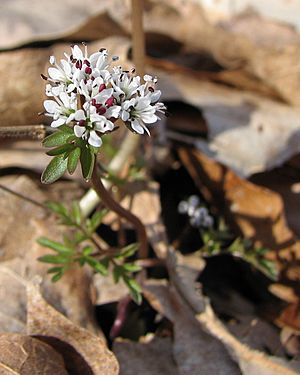Harbinger of spring facts for kids
Quick facts for kids Harbinger of spring |
|
|---|---|
 |
|
| Scientific classification | |
| Genus: |
Erigenia
|
| Species: |
bulbosa
|
Erigenia bulbosa, also known as the harbinger of spring or pepper and salt, is a small plant that comes back every year. It belongs to the Apiaceae family, which is also known as the carrot family. This plant is super special because it's the only species in its group, called Erigenia. People call it the "harbinger of spring" because it's one of the very first wild flowers to bloom. You can find it in rich forests across the central United States. It usually flowers from late February to early April, letting everyone know spring is on its way!
Contents
What It Looks Like
This tiny plant is a "spring ephemeral". This means it grows, flowers, and produces seeds all in a short time during spring. Then it disappears until the next year. It only grows about 5–15 cm tall when it's flowering.
Each plant grows from a round bulb buried in the ground. A single purplish stem comes up, and at the top, it has a cluster of flowers shaped like an umbrella. The flowers have white petals and large, dark reddish parts called anthers. These anthers hold the pollen.
The petals are shaped like teardrops and are about 3-4 millimeters long. They are spaced far apart and don't touch each other. Like other plants in the carrot family, its leaves wrap around the stem at the bottom. They are also divided into many small sections, looking a bit feathery.
Where It Lives
The harbinger of spring is found in rich hardwood forests across eastern North America. It grows as far north as central New York and southern Wisconsin. To the west, it reaches the western Ozarks. To the south, it can be found in central Alabama. You can also spot it in the very southern part of Ontario, Canada.
How It Grows and Interacts
This plant often grows near other early spring flowers. These include spring beauty (Claytonia virginica) and cut-leaf toothwort (Cardamine laciniata).
Many different insects help pollinate these early spring flowers. Solitary bees are very important pollinators. Flies and honey bees also help move pollen from flower to flower.
Erigenia bulbosa flowers don't make a lot of nectar individually. Nectar is a sweet liquid that attracts pollinators. However, many flowers grow close together in one cluster. This makes it easier for pollinators to find enough nectar. The nectar from E. bulbosa contains only one type of sugar, called fructose.
Some states protect this special plant. In New York and Wisconsin, it is considered an endangered plant. This means it is at risk of disappearing. In Pennsylvania, it is listed as threatened, meaning it could become endangered soon.
What It's Used For
The bulb of the harbinger of spring plant can be eaten. You can eat it either cooked or raw.
The Cherokee people, a Native American tribe, used this plant as medicine. They were known to chew parts of it to help with toothaches. Today, some people also plant Erigenia bulbosa in their native wildflower gardens.
Gallery
See also
 In Spanish: Erigenia bulbosa para niños
In Spanish: Erigenia bulbosa para niños



